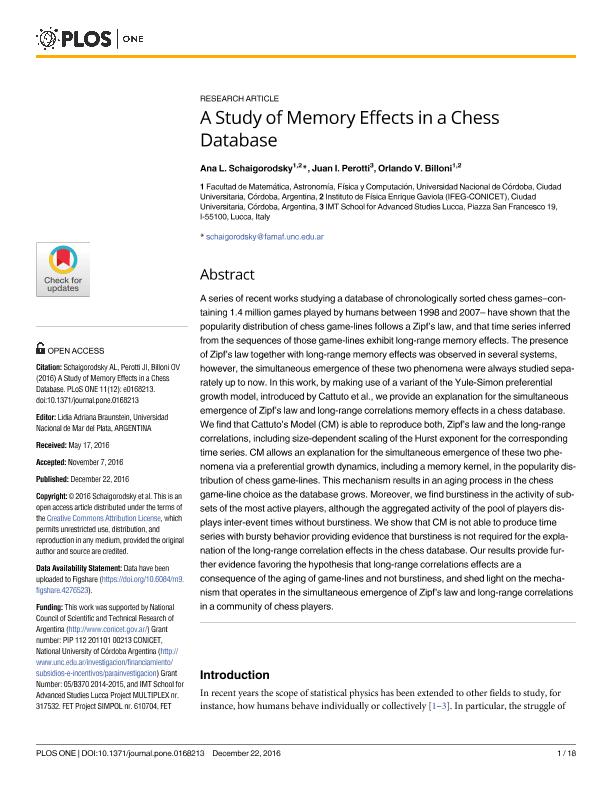Artículo
A Study of Memory Effects in a Chess Database
Fecha de publicación:
12/2016
Editorial:
Public Library of Science
Revista:
Plos One
ISSN:
1932-6203
Idioma:
Inglés
Tipo de recurso:
Artículo publicado
Clasificación temática:
Resumen
A series of recent works studying a database of chronologically sorted chess games-containing 1.4 million games played by humans between 1998 and 2007-have shown that the popularity distribution of chess game-lines follows a Zipf's law, and that time series inferred from the sequences of those game-lines exhibit long-range memory effects. The presence of Zipf's law together with long-range memory effects was observed in several systems, however, the simultaneous emergence of these two phenomena were always studied separately up to now. In this work, by making use of a variant of the Yule-Simon preferential growth model, introduced by Cattuto et al., we provide an explanation for the simultaneous emergence of Zipf's law and long-range correlations memory effects in a chess database. We find that Cattuto's Model (CM) is able to reproduce both, Zipf's law and the long-range correlations, including size-dependent scaling of the Hurst exponent for the corresponding time series. CM allows an explanation for the simultaneous emergence of these two phenomena via a preferential growth dynamics, including a memory kernel, in the popularity distribution of chess game-lines. This mechanism results in an aging process in the chess game-line choice as the database grows. Moreover, we find burstiness in the activity of subsets of the most active players, although the aggregated activity of the pool of players displays inter-event times without burstiness. We show that CM is not able to produce time series with bursty behavior providing evidence that burstiness is not required for the explanation of the long-range correlation effects in the chess database. Our results provide further evidence favoring the hypothesis that long-range correlations effects are a consequence of the aging of game-lines and not burstiness, and shed light on the mechanism that operates in the simultaneous emergence of Zipf's law and long-range correlations in a community of chess players.
Palabras clave:
Zipf law
,
Long range memory
,
Burstiness
Archivos asociados
Licencia
Identificadores
Colecciones
Articulos(IFEG)
Articulos de INST.DE FISICA ENRIQUE GAVIOLA
Articulos de INST.DE FISICA ENRIQUE GAVIOLA
Citación
Schaigorodsky, Ana Laura; Perotti, Juan Ignacio; Billoni, Orlando Vito; A Study of Memory Effects in a Chess Database; Public Library of Science; Plos One; 11; 12; 12-2016; 1-18
Compartir
Altmétricas




